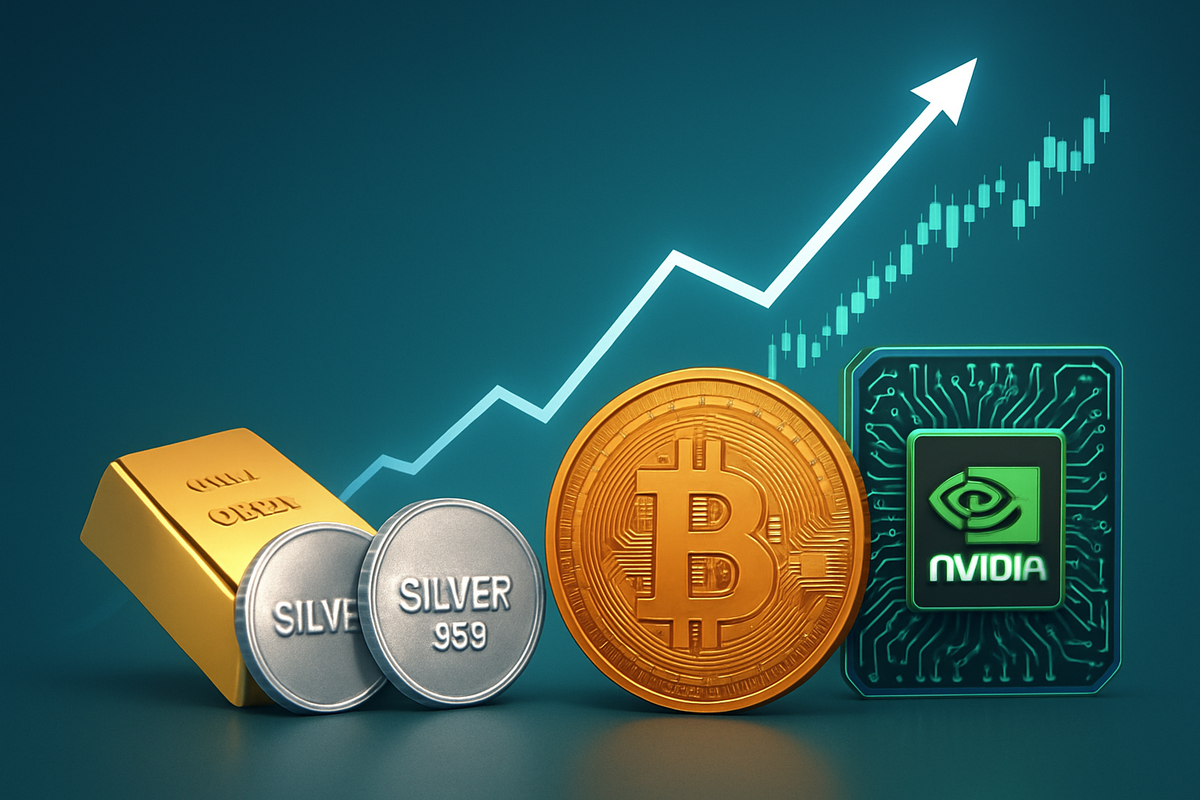
November 6, 2025 – Since the election of Donald Trump in November 2016, the financial landscape has undergone a dramatic transformation, characterized by unprecedented growth in nascent technologies and digital assets, alongside a steadfast performance from traditional safe havens. While gold and silver have delivered respectable returns, providing a bulwark against economic uncertainties, their gains have been significantly overshadowed by the explosive ascent of the broader stock market, and particularly, the meteoric rise of Bitcoin and NVIDIA. On Thursday, November 6, 2025, markets showed a mixed bag, with precious metals experiencing modest gains after cutting an earlier rally, while tech stocks and cryptocurrencies navigated their own recent volatilities.
The period spanning from November 2016 to November 2025 has been a testament to the diverse forces shaping global finance. Gold, a perennial favorite for investors seeking stability, has seen its price per ounce climb from approximately $1,275.64 on November 8, 2016, to $3,990.20 by November 6, 2025, representing a robust increase of over 212%. Silver, often moving in tandem with gold but with higher volatility, also posted impressive gains, rising from $18.34 to $48.61 per ounce, a surge of over 165%. These figures underscore the enduring appeal of precious metals as a hedge against inflation and geopolitical instability, themes that have been prevalent throughout the post-2016 era.
However, the narrative shifts dramatically when examining the performance of other asset classes. The S&P 500, a benchmark for the broader U.S. stock market, saw its value soar from $2,139.56 to $6,796.29, an increase of nearly 218%. This growth reflects a period of sustained economic expansion, corporate innovation, and favorable monetary policies. Yet, even these substantial gains pale in comparison to the digital frontier and the semiconductor revolution. Bitcoin, the pioneering cryptocurrency, which traded at a mere $709.85 in November 2016, astonishingly surged to $102,967 by November 6, 2025, marking an astounding increase of over 14,402%. Similarly, NVIDIA (NASDAQ: NVDA), a titan in the graphics processing unit (GPU) and artificial intelligence (AI) sectors, witnessed an astronomical rise from an adjusted price of $1.76 to $195.21, a staggering gain of over 10,991%.
On the immediate horizon of Thursday, November 6, 2025, market movements painted a nuanced picture. Gold, after an earlier rally, settled with a modest increase, trading at $3,990.20 per ounce. This followed a period of fluctuations, including an all-time high in early October before a recent dip. Silver also saw a slight uptick to $48.61 per ounce, building on a strong year that saw it reach an all-time high of $54.49 in October 2025. Meanwhile, the S&P 500 and the tech-heavy Nasdaq Composite experienced slight pullbacks in early trading, reflecting investor caution amidst ongoing evaluations of AI valuations and discussions surrounding potential Supreme Court hearings on Trump-era tariffs. Bitcoin, despite recent volatility that saw it dip below $100,000, showed signs of stabilization, trading around $102,967, with analysts suggesting it might be entering an "opportunity zone." NVIDIA (NASDAQ: NVDA) mirrored the broader tech sector's cautious trading, experiencing a minor dip but maintaining strong analyst confidence due to its pivotal role in the AI boom.
Diverse Fortunes Across the Market Spectrum
The divergent performances since 2016 have created clear winners and losers across various industries. Companies deeply entrenched in the precious metals sector, such as prominent gold miners like Barrick Gold (NYSE: GOLD) and Newmont (NYSE: NEM), have undoubtedly benefited from the sustained appreciation in gold and silver prices. Their revenues and profit margins are directly tied to the value of the metals they extract, meaning the multi-year rally has provided a strong tailwind for their operations and shareholder returns. However, their growth, while solid, has been more incremental compared to the exponential expansion seen in other sectors.
On the other end of the spectrum, technology companies, particularly those at the forefront of the artificial intelligence revolution, have seen unprecedented gains. NVIDIA (NASDAQ: NVDA) stands as the quintessential example, its stock performance intrinsically linked to its dominance in AI hardware and software. The insatiable demand for GPUs to power data centers, AI research, and various technological advancements has propelled NVIDIA to become one of the most valuable companies globally. Other semiconductor firms and AI-driven software companies have also ridden this wave, experiencing significant capital appreciation.
The cryptocurrency ecosystem has also created a new class of beneficiaries. Companies operating crypto exchanges, blockchain technology firms, and those providing infrastructure for digital assets have thrived alongside Bitcoin's ascent. While highly volatile, the long-term trend for Bitcoin and other major cryptocurrencies has been overwhelmingly positive, attracting a new generation of investors and creating substantial wealth for early adopters and industry participants. Traditional financial institutions that have embraced or invested in these emerging technologies have also seen their portfolios diversified and enhanced.
A Landscape Redefined: Trends, Policies, and Precedents
The period since Trump's election has been characterized by several overarching trends that have collectively redefined the financial landscape. Firstly, the accelerating pace of technological innovation, particularly in artificial intelligence and machine learning, has fundamentally reshaped industries and created new avenues for wealth creation. NVIDIA's trajectory is a direct reflection of this paradigm shift, where technological prowess translates into market dominance.
Secondly, the rise of digital assets like Bitcoin represents a significant, albeit sometimes controversial, shift in investment philosophy. What began as a niche interest has matured into a recognized asset class, driven by a blend of speculative interest, a desire for decentralized finance, and a hedge against traditional financial systems. This trend has also brought forth regulatory challenges and policy debates, with governments worldwide grappling with how to integrate and oversee this burgeoning sector. The Supreme Court hearing on Trump-era tariffs, mentioned in recent market discussions, also highlights the lingering policy implications of that administration.
Thirdly, persistent global uncertainties – ranging from geopolitical tensions to inflationary pressures – have underscored the traditional role of gold and silver as safe-haven assets. Central banks globally have continued to accumulate gold, signaling its enduring appeal as a store of value. This sustained demand, coupled with inflationary concerns, has provided a strong floor for precious metal prices, ensuring their continued relevance in diversified portfolios. Historically, gold has often performed well during periods of political and economic uncertainty, a precedent that has largely held true since 2016.
Navigating the Future: Opportunities and Challenges Ahead
Looking ahead, the market dynamics that have played out over the last nine years are likely to continue evolving, presenting both opportunities and challenges for investors. In the short term, volatility is expected to remain a constant, particularly in the high-growth tech and cryptocurrency sectors. Investors may witness continued rotations between growth-oriented assets and more defensive plays like precious metals, depending on prevailing economic data, inflation outlooks, and geopolitical developments.
Long-term possibilities include the sustained growth of the AI sector, with companies like NVIDIA (NASDAQ: NVDA) continuing to innovate and expand their market reach. The increasing institutional adoption of cryptocurrencies could also provide further tailwinds for Bitcoin and the broader digital asset market, potentially reducing some of its inherent volatility. For precious metals, their role as an inflation hedge and a safe haven is expected to endure, making them a crucial component of a balanced portfolio, especially in an environment where central banks might face renewed pressure to ease monetary policies.
Strategic pivots will be essential for investors. This includes adapting to new regulatory frameworks for cryptocurrencies, assessing the sustainability of AI valuations, and understanding the impact of evolving monetary policies on both traditional and alternative assets. Market opportunities may emerge in overlooked sectors or in companies that are poised to capitalize on the next wave of technological innovation or shifts in global economic power. Conversely, challenges will include managing the risks associated with highly speculative assets and navigating potential market corrections in overextended sectors.
A Complex Tapestry of Market Performance
The period since Donald Trump's election in November 2016 has woven a complex tapestry of market performance. While gold and silver have demonstrated commendable resilience and significant appreciation, solidifying their roles as crucial safe havens, their returns have been dramatically eclipsed by the exponential growth witnessed in the technology sector, epitomized by NVIDIA (NASDAQ: NVDA), and the revolutionary ascent of Bitcoin. The S&P 500 has also seen substantial growth, reflecting a robust underlying economy.
Moving forward, the market will likely remain influenced by a confluence of factors: the relentless march of technological progress, particularly in AI; the ongoing maturation and regulatory evolution of the cryptocurrency landscape; and persistent concerns over inflation and geopolitical stability that underscore the value of precious metals. Investors should maintain a keen eye on central bank policies, corporate earnings, especially from the tech giants, and any significant shifts in global political and economic sentiment. The enduring lesson from this era is the importance of diversification and an understanding of how different asset classes respond to a rapidly changing world.
This content is intended for informational purposes only and is not financial advice





